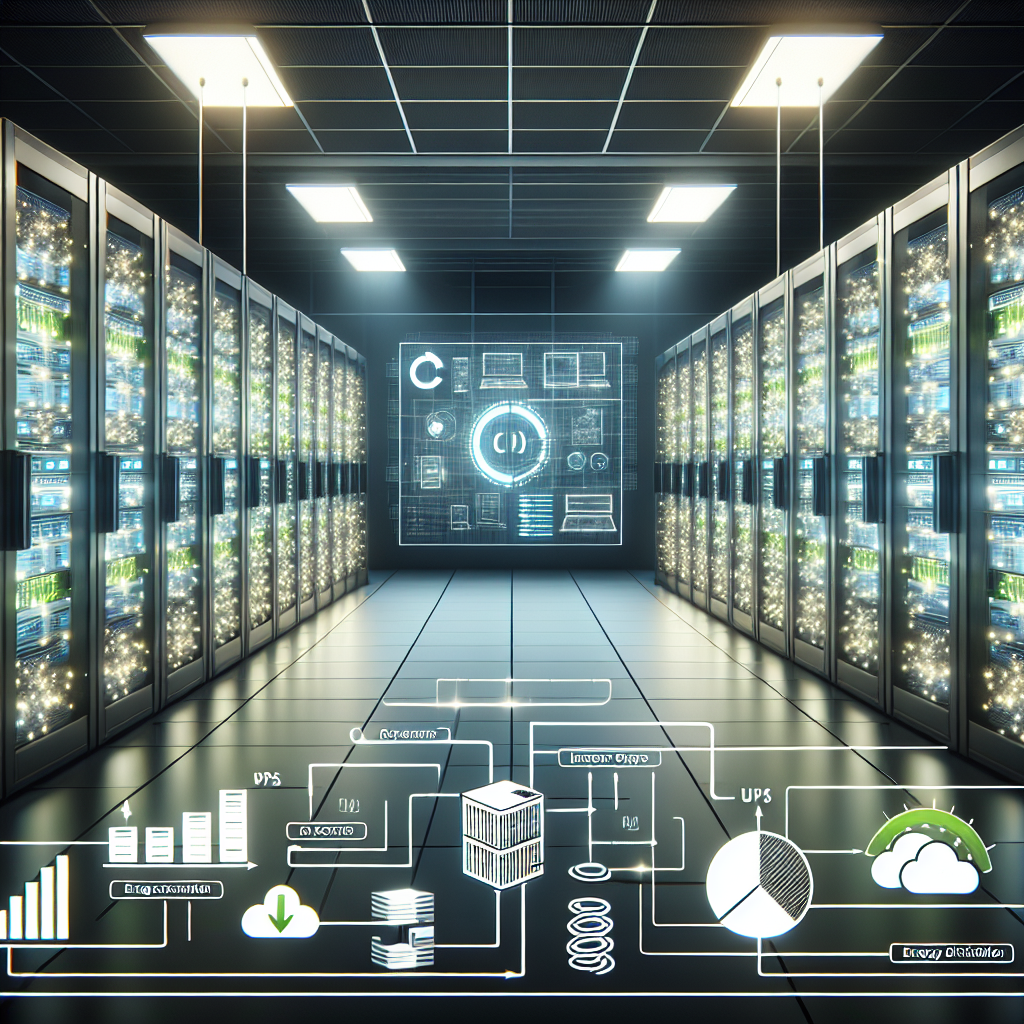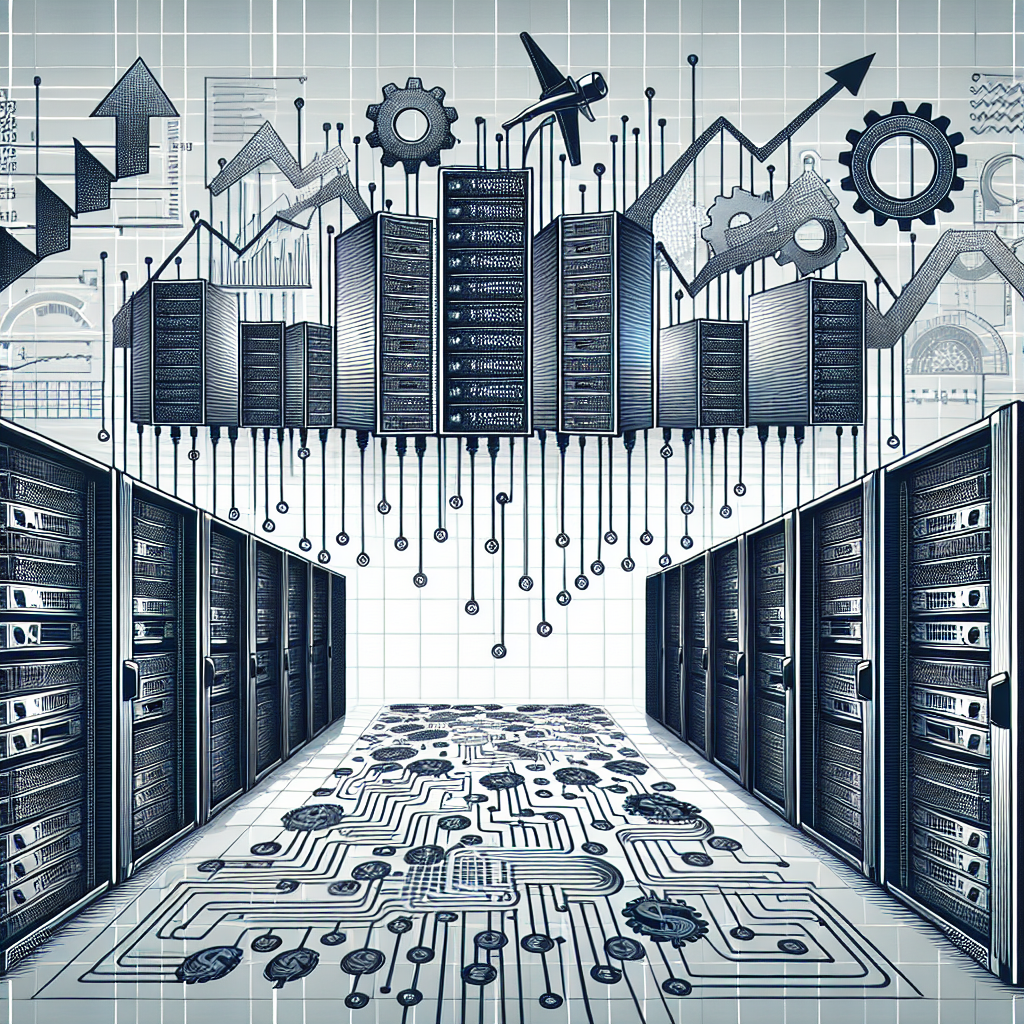Your cart is currently empty!
Tag: Savings

Maximizing Energy Savings with Data Center Power Distribution Strategies
In today’s digital age, data centers play a crucial role in driving innovation and supporting the growing demands of businesses and consumers. However, with the increasing reliance on data centers comes the need for efficient power distribution strategies to maximize energy savings and reduce operational costs.One of the key challenges faced by data center operators is managing the high energy consumption associated with cooling and powering the equipment. In fact, data centers are known to be some of the most energy-intensive facilities, consuming vast amounts of electricity to keep servers and networking equipment running smoothly.
To address this issue, data center operators are turning to advanced power distribution strategies to optimize energy usage and reduce their carbon footprint. By implementing smart power management solutions, data center operators can achieve significant energy savings while ensuring reliable and efficient operations.
One effective strategy for maximizing energy savings in data centers is through the use of power distribution units (PDUs) with built-in monitoring and control capabilities. These intelligent PDUs enable operators to monitor power usage in real-time, identify inefficiencies, and implement measures to improve energy efficiency.
Another key aspect of maximizing energy savings in data centers is the deployment of energy-efficient cooling systems. By using advanced cooling technologies such as containment systems, hot aisle/cold aisle configurations, and variable speed fans, data center operators can reduce the energy consumption required for cooling while maintaining optimal operating temperatures.
In addition to implementing advanced power distribution and cooling strategies, data center operators can also benefit from incorporating renewable energy sources into their operations. By harnessing the power of solar panels, wind turbines, or other clean energy sources, data centers can reduce their reliance on traditional fossil fuels and lower their overall carbon footprint.
Furthermore, data center operators can leverage data analytics and machine learning algorithms to optimize power distribution and energy usage. By analyzing historical power consumption data, operators can identify trends, patterns, and inefficiencies, allowing them to make informed decisions on how to optimize energy usage and reduce costs.
In conclusion, maximizing energy savings in data centers requires a holistic approach that combines advanced power distribution strategies, energy-efficient cooling systems, renewable energy sources, and data analytics. By implementing these measures, data center operators can achieve significant cost savings, reduce their environmental impact, and ensure the long-term sustainability of their operations.

Maximizing Efficiency and Cost Savings with Data Center HVAC Systems
Data centers are essential for businesses to store, manage, and process their data. With the increasing reliance on technology, data centers are becoming more prevalent and crucial than ever before. However, operating a data center can be a costly endeavor, especially when it comes to cooling and maintaining the servers. HVAC systems are essential for regulating the temperature and humidity levels in data centers to ensure optimal performance and prevent equipment failure. Maximizing efficiency and cost savings with data center HVAC systems is crucial for businesses to reduce their operational expenses and improve overall performance.One of the most effective ways to maximize efficiency and cost savings with data center HVAC systems is through regular maintenance and upgrades. By ensuring that the HVAC system is running efficiently, businesses can reduce energy consumption and improve the lifespan of the equipment. Regular maintenance includes cleaning or replacing filters, checking for leaks or damaged components, and calibrating temperature and humidity controls. Upgrading to newer, more energy-efficient HVAC systems can also help reduce energy consumption and lower operational costs in the long run.
Another way to maximize efficiency and cost savings with data center HVAC systems is by implementing temperature and humidity monitoring systems. By monitoring and regulating the temperature and humidity levels in real-time, businesses can prevent overheating and humidity-related issues that can lead to equipment failure. This proactive approach can help reduce downtime and maintenance costs associated with HVAC system failures.
Implementing energy-saving strategies, such as using free cooling techniques or optimizing airflow distribution, can also help maximize efficiency and cost savings with data center HVAC systems. Free cooling techniques, such as using outside air or water for cooling during cooler temperatures, can significantly reduce energy consumption and lower operational costs. Optimizing airflow distribution can help ensure that the cooling air is reaching all areas of the data center efficiently, reducing the need for additional cooling equipment.
Furthermore, businesses can consider implementing modular or scalable HVAC systems to accommodate the changing needs of their data center. Modular HVAC systems allow businesses to add or remove cooling units based on the size and requirements of the data center, providing flexibility and cost savings. Scalable HVAC systems can also help businesses avoid over-sizing or under-sizing their cooling equipment, ensuring optimal energy efficiency and cost savings.
In conclusion, maximizing efficiency and cost savings with data center HVAC systems is crucial for businesses to reduce operational expenses and improve overall performance. By implementing regular maintenance and upgrades, monitoring temperature and humidity levels, implementing energy-saving strategies, and using modular or scalable HVAC systems, businesses can optimize their cooling systems and achieve significant cost savings. Investing in efficient HVAC systems is not only beneficial for the bottom line but also essential for ensuring the reliability and performance of data centers in the long run.

Optimizing Data Center Operations for Cost Savings and Sustainability
In today’s digital age, data centers play a crucial role in storing and processing vast amounts of information for businesses of all sizes. However, with the increasing demand for data storage and processing power, data centers are facing challenges in terms of cost and sustainability. In order to address these challenges, it is important for data center operators to optimize their operations for cost savings and sustainability.One of the key ways to optimize data center operations for cost savings is by improving energy efficiency. Data centers consume a significant amount of energy to power servers, cooling systems, and other equipment. By implementing energy-efficient practices, such as using virtualization technology to consolidate servers and optimizing cooling systems, data center operators can reduce their energy consumption and lower their operational costs.
In addition to energy efficiency, data center operators can also save costs by implementing automation and monitoring systems. By automating routine tasks and monitoring equipment performance in real-time, data center operators can identify and address issues before they escalate, reducing downtime and maintenance costs.
Furthermore, data center operators can achieve cost savings by implementing a strategic procurement strategy. By negotiating better contracts with vendors, consolidating purchasing power, and leveraging economies of scale, data center operators can lower their equipment and maintenance costs.
In addition to cost savings, optimizing data center operations for sustainability is also important for reducing the environmental impact of data centers. By implementing energy-efficient practices, such as using renewable energy sources and recycling waste heat, data center operators can reduce their carbon footprint and contribute to a more sustainable future.
Overall, optimizing data center operations for cost savings and sustainability requires a holistic approach that combines energy efficiency, automation, strategic procurement, and sustainability practices. By implementing these strategies, data center operators can reduce their operational costs, improve their environmental performance, and ensure the long-term sustainability of their operations.

Unlocking Cost Savings and Efficiency with DCIM Technologies
As businesses continue to grow and expand, the need for efficient and cost-effective data center management solutions has become increasingly important. Data Center Infrastructure Management (DCIM) technologies have emerged as a key tool in helping organizations unlock cost savings and improve overall efficiency in their data centers.DCIM technologies provide a comprehensive platform for monitoring and managing all aspects of a data center’s infrastructure, including power usage, cooling systems, server utilization, and more. By consolidating and analyzing data from various sources, DCIM solutions enable data center managers to make informed decisions that can optimize performance, reduce energy consumption, and ultimately save money.
One of the key benefits of DCIM technologies is their ability to improve energy efficiency in data centers. By monitoring power usage and identifying areas of waste, organizations can implement strategies to reduce energy consumption and lower utility costs. For example, DCIM software can help identify underutilized servers or cooling systems that are running inefficiently, allowing businesses to make adjustments and optimize their operations.
In addition to energy savings, DCIM technologies also help organizations maximize the use of their existing resources. By providing real-time visibility into server utilization and capacity, data center managers can identify opportunities to consolidate hardware, improve workload distribution, and increase overall efficiency. This not only helps reduce operational costs but also extends the lifespan of existing infrastructure, delaying the need for costly upgrades or expansions.
Furthermore, DCIM technologies can streamline processes and improve overall data center management. By centralizing monitoring and management functions, organizations can reduce the time and effort required to manage their infrastructure. Automated alerts and notifications help identify potential issues before they escalate, allowing for quicker resolution and minimizing downtime. This proactive approach to management can help organizations improve service levels, enhance reliability, and ultimately save money in the long run.
Overall, DCIM technologies offer a wide range of benefits for organizations looking to unlock cost savings and improve efficiency in their data centers. By providing real-time visibility, optimizing resource utilization, and streamlining management processes, DCIM solutions help businesses make informed decisions that drive operational excellence and maximize ROI. As data centers continue to play a critical role in supporting business operations, investing in DCIM technologies is essential for organizations looking to stay competitive and thrive in today’s digital economy.

Driving Sustainability and Cost Savings with Effective Data Center Lifecycle Management
In today’s digital age, data centers play a crucial role in powering the technology that drives our everyday lives. From storing and processing massive amounts of data to hosting websites and applications, data centers are essential for businesses to operate efficiently and effectively. However, the environmental impact of data centers cannot be ignored. With the increasing demand for computing power, data centers are consuming more energy than ever before, leading to concerns about their sustainability.To address these concerns, many companies are turning to effective data center lifecycle management strategies to drive sustainability and cost savings. By optimizing the lifecycle of their data centers, businesses can reduce energy consumption, lower operational costs, and minimize their impact on the environment.
One key aspect of data center lifecycle management is the efficient use of resources. By regularly monitoring and analyzing data center performance, businesses can identify areas where energy is being wasted and implement strategies to improve efficiency. This can include consolidating servers, virtualizing resources, and implementing energy-efficient hardware and cooling systems. By optimizing resource utilization, businesses can reduce energy consumption and lower their operating costs.
Another important aspect of data center lifecycle management is proper maintenance and upkeep of equipment. Regular maintenance and upgrades can help prolong the life of data center equipment, reducing the need for costly replacements and minimizing downtime. By implementing a proactive maintenance schedule, businesses can ensure that their data center infrastructure remains reliable and efficient, leading to cost savings in the long run.
In addition to optimizing resource utilization and maintaining equipment, businesses can also drive sustainability and cost savings through data center consolidation and modernization. By consolidating multiple data centers into a smaller number of more efficient facilities, businesses can reduce their overall energy consumption and operating costs. Furthermore, by modernizing their data center infrastructure with the latest technologies, businesses can improve performance, reliability, and efficiency, ultimately driving cost savings and sustainability.
Overall, effective data center lifecycle management is essential for driving sustainability and cost savings in today’s digital world. By optimizing resource utilization, maintaining equipment, and modernizing infrastructure, businesses can reduce their environmental impact, lower their operating costs, and improve overall efficiency. As the demand for computing power continues to grow, businesses must prioritize sustainability and cost savings in their data center operations to ensure long-term success in a rapidly evolving technological landscape.

Leveraging Data Center Audits to Drive Continuous Improvement and Cost Savings
Data centers are the backbone of modern business operations, housing the critical infrastructure that supports everything from customer data to financial transactions. With the increasing reliance on data centers for business operations, it is crucial for organizations to ensure that their data centers are operating efficiently and effectively. One way to achieve this is through regular data center audits.Data center audits are essential for identifying potential issues and inefficiencies within a data center environment. By conducting a thorough audit, organizations can gain valuable insights into the performance of their data center infrastructure, identify areas for improvement, and drive cost savings.
One of the key benefits of data center audits is the ability to identify and address inefficiencies in the data center environment. Through a comprehensive audit, organizations can pinpoint areas where energy is being wasted, equipment is underutilized, or processes are inefficient. By addressing these inefficiencies, organizations can optimize their data center operations, improve performance, and reduce operating costs.
In addition to driving operational efficiency, data center audits can also help organizations identify potential risks and vulnerabilities within their data center environment. By conducting a security audit, organizations can assess the effectiveness of their security measures, identify potential vulnerabilities, and implement necessary safeguards to protect their data and infrastructure from cyber threats.
Furthermore, data center audits can help organizations ensure compliance with industry regulations and best practices. By conducting a compliance audit, organizations can assess their adherence to standards and regulations, identify areas of non-compliance, and implement necessary measures to meet regulatory requirements.
Overall, data center audits play a crucial role in driving continuous improvement and cost savings within organizations. By leveraging the insights gained from audits, organizations can optimize their data center operations, enhance performance, reduce costs, and ensure the security and compliance of their data center environment.
In conclusion, data center audits are a valuable tool for organizations looking to improve the efficiency, performance, and security of their data center operations. By conducting regular audits and leveraging the insights gained, organizations can drive continuous improvement, reduce costs, and ensure the effectiveness of their data center infrastructure.

Maximizing Efficiency and Cost Savings with Data Center Network Infrastructure
In today’s fast-paced digital world, data centers play a crucial role in supporting businesses’ IT infrastructure and storing vast amounts of data. With the increasing demand for data processing and storage, maximizing efficiency and cost savings in data center network infrastructure has become essential for organizations looking to stay competitive and agile.One of the key ways to achieve efficiency and cost savings in data center network infrastructure is through proper planning and design. By carefully assessing the organization’s current and future needs, businesses can optimize their network infrastructure to meet performance requirements while minimizing unnecessary expenses.
One strategy for maximizing efficiency is to consolidate network equipment and reduce the number of physical devices in the data center. By implementing virtualization technologies and software-defined networking (SDN), organizations can streamline network operations and reduce the complexity of managing multiple hardware devices.
Another way to enhance efficiency and cost savings is by implementing energy-efficient networking equipment and practices. Data centers consume a significant amount of power, and by using energy-efficient switches, routers, and servers, organizations can reduce their electricity bills and minimize their carbon footprint. Additionally, implementing best practices such as airflow optimization and server consolidation can further reduce energy consumption and operating costs.
Utilizing automation and orchestration tools can also help organizations maximize efficiency in data center network infrastructure. By automating routine tasks such as provisioning, monitoring, and troubleshooting, businesses can free up IT staff to focus on more strategic initiatives and improve overall network performance.
Furthermore, organizations can leverage data analytics and monitoring tools to gain insights into network performance and identify areas for optimization. By analyzing network traffic patterns, identifying bottlenecks, and proactively addressing issues, businesses can ensure that their network infrastructure is operating at peak efficiency and performance levels.
In conclusion, maximizing efficiency and cost savings in data center network infrastructure is essential for organizations looking to remain competitive and agile in today’s digital landscape. By carefully planning and designing their network infrastructure, implementing energy-efficient equipment and practices, leveraging automation tools, and utilizing data analytics, businesses can optimize their network operations and achieve significant cost savings. Investing in efficient and scalable network infrastructure is not only beneficial for the organization’s bottom line but also ensures that they can meet the growing demands of their IT infrastructure in the future.

The Benefits of Outsourcing Data Center Facilities Management: Cost Savings and Expertise
In today’s digital age, data centers are becoming increasingly essential for businesses to store, manage, and process their vast amounts of data. With the rise of cloud computing and the Internet of Things, the demand for data center facilities management is higher than ever before. Many businesses are turning to outsourcing data center facilities management as a cost-effective and efficient solution.One of the main benefits of outsourcing data center facilities management is cost savings. Managing a data center in-house can be incredibly expensive, as it requires a significant investment in infrastructure, equipment, and personnel. By outsourcing this task to a third-party provider, businesses can reduce their operating costs and free up capital for other strategic initiatives.
Outsourcing data center facilities management also allows businesses to tap into the expertise and experience of a specialized team of professionals. Data center management requires a high level of technical knowledge and skills, which can be difficult to find and retain in-house. By partnering with a reputable data center facilities management provider, businesses can benefit from the expertise of experienced professionals who are dedicated to ensuring the security, reliability, and performance of their data centers.
Additionally, outsourcing data center facilities management can help businesses improve their operational efficiency and scalability. A third-party provider can offer advanced monitoring and management tools, as well as best practices and industry standards, to optimize the performance of the data center and ensure maximum uptime. This can help businesses better meet the demands of their customers and adapt to changing market conditions.
Furthermore, outsourcing data center facilities management can also help businesses mitigate risks and ensure compliance with regulatory requirements. Data centers are subject to a variety of security threats, including cyberattacks, natural disasters, and equipment failures. By partnering with a reputable data center facilities management provider, businesses can benefit from advanced security measures, disaster recovery plans, and compliance audits to protect their data and ensure business continuity.
In conclusion, outsourcing data center facilities management offers businesses a cost-effective and efficient solution to managing their data centers. By partnering with a specialized provider, businesses can benefit from cost savings, expertise, operational efficiency, scalability, risk mitigation, and compliance assurance. Overall, outsourcing data center facilities management can help businesses focus on their core competencies and drive innovation and growth in today’s digital economy.

The Impact of Data Center Inspections on Cost Savings and Operational Efficiency
Data centers are a critical component of modern businesses, serving as the backbone for storing, processing, and managing vast amounts of data. With the increasing reliance on technology, data centers are becoming more complex and costly to operate. As such, it is essential for organizations to prioritize regular inspections to ensure optimal performance, cost savings, and operational efficiency.Data center inspections involve a comprehensive assessment of the facility’s infrastructure, equipment, and systems to identify any potential issues or areas for improvement. By conducting regular inspections, organizations can proactively address any issues before they escalate into costly downtime or disruptions. This proactive approach not only helps to minimize the risk of unexpected failures but also ensures that the data center is operating at peak efficiency.
One of the key benefits of data center inspections is cost savings. By identifying and addressing inefficiencies, organizations can reduce energy consumption, improve cooling efficiency, and optimize server utilization. This can lead to significant cost savings in terms of electricity bills, maintenance costs, and equipment upgrades. Additionally, regular inspections can help organizations identify opportunities for consolidation, virtualization, and cloud migration, further reducing operational costs and improving overall efficiency.
Furthermore, data center inspections can also have a positive impact on operational efficiency. By ensuring that all systems are functioning properly and efficiently, organizations can minimize downtime, improve performance, and enhance the overall reliability of the data center. This, in turn, can lead to increased productivity, customer satisfaction, and competitive advantage.
In conclusion, data center inspections play a crucial role in ensuring cost savings and operational efficiency for organizations. By proactively identifying and addressing issues, organizations can optimize their data center infrastructure, reduce operational costs, and improve overall performance. As technology continues to evolve and data centers become more complex, regular inspections will be essential to staying ahead of the curve and maintaining a competitive edge in the digital age.

Cloud Computing: Additional Opportunities And Savings Need To Be Pursued

Cloud Computing: Additional Opportunities And Savings Need To Be Pursued
Price : 17.23
Ends on : N/A
View on eBay
Cloud computing has become an integral part of modern business operations, offering unparalleled flexibility, scalability, and cost-efficiency. However, there are still additional opportunities and savings that need to be pursued in order to fully maximize the benefits of this technology.One key opportunity lies in optimizing cloud resources and usage. Many organizations are not fully utilizing the capabilities of their cloud infrastructure, resulting in wasted resources and increased costs. By closely monitoring and analyzing cloud usage patterns, businesses can identify areas for improvement and make the necessary adjustments to ensure optimal efficiency.
Another opportunity for cost savings in cloud computing lies in exploring alternative pricing models and providers. With a growing number of cloud service providers entering the market, businesses have more options than ever before. By comparing pricing structures and services offered by different providers, organizations can potentially find better deals and reduce their overall cloud computing expenses.
Additionally, implementing automation and orchestration tools can help streamline cloud operations and reduce manual labor costs. By automating routine tasks and workflows, businesses can free up their IT teams to focus on more strategic initiatives, ultimately driving further cost savings and operational efficiencies.
In conclusion, while cloud computing offers a wide range of benefits, there are still additional opportunities and savings that can be pursued. By optimizing cloud resources, exploring alternative providers, and implementing automation tools, businesses can further enhance the value of their cloud investments and achieve greater cost efficiencies.
#Cloud #Computing #Additional #Opportunities #Savings #Pursued
